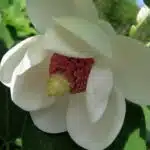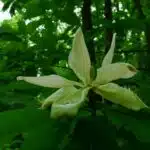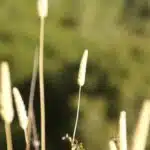Magnolia grandiflora, commonly known as the southern magnolia, is a stunning tree with glossy green leaves and large, fragrant flowers. This species of magnolia is native to the southeastern United States and has become a popular ornamental tree due to its beauty and versatility. However, growing a healthy magnolia grandiflora requires proper care and attention.
For those looking to plant or maintain this iconic tree, it is essential to understand the environmental requirements and cultural practices necessary for successful growth. This article will provide an in-depth guide on how to grow magnolia grandiflora from planting to maintenance, covering key topics such as soil preparation, watering, fertilization, pruning, and pest management. By following these guidelines, gardeners can ensure their magnolia grandiflora thrives in their landscape for years to come.
Understanding The Southern Magnolia Tree
The Southern Magnolia tree, also known as Magnolia grandiflora, is a majestic and iconic symbol of the American South. It can grow up to 80 feet tall, with a spread of 40-50 feet. Its glossy evergreen leaves are large and leathery, with a deep green color on top and rusty brown fuzz underneath. The tree’s massive white flowers bloom in late spring to early summer, filling the air with their sweet fragrance.
Tree anatomy plays an important role in understanding how to grow a healthy Southern Magnolia. Its roots are shallow but wide-spreading, so it needs ample space to grow without interference from other trees or structures. The trunk is straight and sturdy, with bark that is smooth when young but develops furrows as it ages. The branches are thick and horizontal, forming a broad canopy that provides shade in hot weather.
When considering how to grow Magnolia grandiflora, it’s helpful to compare it to other species of magnolias. Unlike the deciduous magnolias that lose their leaves in winter, the Southern Magnolia retains its foliage year-round. Additionally, this species prefers acidic soil with good drainage and moderate moisture levels. Understanding these characteristics will help you choose the ideal location for planting your Southern Magnolia tree.
As you begin planning where to plant your Southern Magnolia tree, keep in mind the importance of selecting a spot that meets its specific needs. In the next section, we will explore the key factors you should consider when choosing a location for planting your Southern Magnolia tree.
Choosing The Right Location For Planting
When it comes to growing Magnolia Grandiflora, choosing the right location is crucial for the health and success of the tree. One of the most important factors to consider is sun exposure. These trees thrive in areas with full sun or partial shade, so be sure to choose a spot that receives at least six hours of direct sunlight each day. A location that’s shaded by other trees or buildings will hinder their growth.
Another key factor to consider is soil pH. Magnolia Grandiflora prefers soil that’s slightly acidic, with a pH between 5.0 and 6.5. If your soil is too alkaline, it can be amended with sulfur or iron sulfate. On the other hand, if your soil is too acidic, you can add lime to raise the pH level.
It’s important to note that these are just a few of the many factors to consider when selecting a site for planting Magnolia Grandiflora. Other considerations may include temperature, moisture levels, and wind exposure. With careful planning and preparation, however, you can ensure that your tree has all the conditions it needs to thrive in its new home.
Transition: Now that we’ve discussed how to select the perfect site for your Magnolia Grandiflora tree, let’s move on to another critical step in ensuring healthy growth: soil preparation.
Soil Preparation: The Key To Healthy Growth
After choosing the right location for planting Magnolia Grandiflora, the next crucial step is soil preparation. Soil is a vital component that determines the health and growth of any plant. The soil’s pH level plays an important role in ensuring the plant receives the necessary nutrients for healthy growth. It is essential to note that Magnolia Grandiflora thrives in slightly acidic soil with a pH range of 5.0-6.5.
Organic amendments are useful in improving soil fertility, structure, and texture. They also help retain water and prevent soil erosion. Types of organic amendments include compost, peat moss, manure, and grass clippings. Compost is an excellent source of organic matter rich in nutrients that enhance soil fertility. Peat moss helps improve drainage and moisture retention while manure provides nutrients to the plants as it decomposes.
Table: Organic Amendments
| Type | Benefits |
|---|---|
| Compost | Rich source of organic matter; enhances soil fertility |
| Peat Moss | Improves drainage and moisture retention |
| Manure | Provides nutrients to plants as it decomposes |
| Grass Clippings | Adds nitrogen to the soil; improves water retention |
| Mushroom Compost | Adds potassium, phosphorus, and other micronutrients; enhances water-holding capacity |
Incorporating organic amendments into your Magnolia Grandiflora planting site will not only benefit your tree but also enhance your garden’s overall health. It is crucial to ensure you have adequate knowledge about different types of organic amendments before selecting which one to use on your site. In our subsequent section on watering requirements for Magnolia Grandiflora, we will discuss how proper watering techniques contribute significantly to its growth and development.
Watering Requirements For Magnolia Grandiflora
Magnolia grandiflora is a large, broadleaf evergreen tree that is tolerant to a wide range of soil types and moisture levels. However, optimal watering frequency and soil moisture levels should be considered for best performance and growth. For established trees, watering should occur at least once per week during dry periods, and soil should remain moist but not soggy. In addition, irrigation should be adjusted based on seasonal changes, with increased frequency during periods of high temperatures and low precipitation.
Watering Frequency
As a horticulturalist, it is important to understand the best practices for watering Magnolia Grandiflora. Proper watering frequency is crucial for the health and growth of these trees. The general rule of thumb is to water deeply but infrequently, allowing the soil to dry out slightly between each watering.
Overwatering can lead to root rot and other diseases that can harm the tree’s overall health. Signs of overwatering include yellowing leaves, wilting, and a lack of new growth. On the other hand, under-watering can cause stress on the tree and may result in leaf drop or stunted growth. Signs of under-watering include brown or crispy leaves, as well as drooping branches.
To ensure proper watering frequency for Magnolia Grandiflora, it is important to monitor soil moisture levels regularly. This can be done by sticking a finger into the soil or using a moisture meter. Watering should occur when the top inch of soil feels dry to the touch. During hot summer months, this may mean watering once or twice a week, while cooler seasons may require less frequent watering. By following these best practices and being mindful of signs of over/under watering, you can help your Magnolia Grandiflora thrive for years to come.
Soil Moisture Levels
Proper watering frequency is essential for the health and growth of Magnolia Grandiflora. As a horticulturalist, it is essential to pay attention to the soil moisture levels. Optimal drainage is necessary to ensure that the roots do not get waterlogged or remain too dry. To achieve this, it is important to select an appropriate soil type that provides sufficient drainage.
Irrigation techniques are also crucial in maintaining optimal soil moisture levels. Over-irrigation can lead to waterlogging, which can cause root rot and other diseases. On the other hand, under-irrigation can lead to drought stress, resulting in stunted growth and leaf drop. Therefore, it is important to monitor soil moisture levels regularly using a moisture meter or by sticking a finger into the soil.
To ensure that Magnolia Grandiflora receives adequate water without over or under-watering, it is important to water deeply but infrequently. This allows the soil to dry out slightly between each watering. During hot summer months, this may mean watering once or twice a week with enough water to soak down at least six inches into the soil. Cooler seasons may require less frequent watering. By following these best practices and being mindful of signs of over/under-watering, you can help your Magnolia Grandiflora thrive for years to come while maintaining optimal drainage and irrigation techniques.
Fertilizing Your Tree
One of the most important steps to growing a healthy Magnolia Grandiflora tree is fertilization. Fertilizers provide essential nutrients that promote growth, strengthen branches, and ultimately enhance the tree’s overall appearance. There are various types of fertilizers on the market, but selecting the best ones will depend on your soil type and specific nutritional requirements.
Before applying any fertilizer, it’s essential to do a soil test to determine which nutrients your tree requires. Soil tests help avoid over-fertilization or insufficient nutrient supply, both of which can have adverse effects on tree growth. Generally, Magnolia Grandiflora trees require a balanced fertilizer with equal amounts of nitrogen, phosphorus, and potassium. A slow-release fertilizer applied during the growing season ensures that your tree gets an adequate supply of nutrients throughout its development.
Fertilizing schedule depends on factors such as soil quality and weather conditions in your region. Typically, established trees require two applications per year: once in early spring before new growth begins and again in late summer or early fall to sustain root development over winter. Younger trees may require more frequent applications but should not be over-fertilized as this can lead to excessive foliage growth at the expense of root development. In the next section, we’ll discuss pruning tips for optimal growth that complement fertilization efforts.
Pruning Tips For Optimal Growth
As magnolia grandiflora grows, proper pruning is vital to keep it healthy and promote optimal growth. Pruning frequency depends on the desired shape and size of the tree, but it is typically recommended to prune annually during the dormant season. This will help the tree maintain its natural form and prevent any broken or diseased branches from harming the overall health of the tree.
When pruning magnolia grandiflora, it’s important to use proper techniques to avoid causing damage to the tree. Always make cuts at a 45-degree angle just above a bud or lateral branch junction. Avoid making cuts too close or too far from these points as this can lead to improper healing and potential disease. It’s also wise to remove any crossing branches or those that are growing towards the center of the tree, as they can rub against each other and cause wounds.
In addition to regular pruning, monitoring for pests and diseases is crucial for maintaining a healthy magnolia grandiflora. By frequently inspecting leaves and bark for any signs of infestation or infection, you can catch potential problems early on before they become too severe. In the next section, we will discuss common pests and diseases to watch out for when caring for your magnolia grandiflora tree.
Common Pests And Diseases To Watch Out For
Scale Insects are an insect that can cause harm to Magnolia grandiflora, as they feed on the sap of the plant. Fungal Diseases can cause leaf spots and root rot if not treated quickly. Aphids and caterpillars can both cause leaf damage, while bacterial blight can result in brown or black lesions on the leaves. Mites, viruses, armillaria, thrips, powdery mildew, nematodes, leaf spot, rust, and spider mites are additional pests and diseases to watch out for when caring for Magnolia grandiflora.
Scale Insects
There’s nothing quite like the sight of a healthy Magnolia grandiflora tree. However, as with any plant, it is susceptible to pests and diseases. One common pest that can plague these trees is scale insects. These small, oval-shaped insects suck the sap from the tree and can cause serious damage if not dealt with.
Fortunately, there are natural remedies that can be used to combat scale insects on your Magnolia grandiflora. Ladybugs and lacewings are natural predators of scale insects and can help keep their populations under control. You could also try spraying the tree with a solution made from neem oil or insecticidal soap to kill off any remaining pests.
If your Magnolia grandiflora tree is suffering from a severe infestation of scale insects, you may need to resort to chemical treatments to get rid of them. However, it’s important to use caution when applying these treatments as they can harm beneficial insects as well. Always follow the instructions carefully and avoid using chemicals if possible by first trying natural methods to control the pests.
In conclusion, keeping an eye out for scale insects on your Magnolia grandiflora tree is essential for maintaining its health and beauty. While chemical treatments may be necessary in severe cases, utilizing natural remedies should always be your first line of defense against these pesky pests. With proper care and attention, your Magnolia grandiflora will thrive for years to come.
Fungal Diseases
Fungal diseases are another common issue that can affect Magnolia grandiflora trees. These diseases can cause damage to the leaves, stems, and branches of the tree, leading to stunted growth and a decline in overall health. Some of the most common fungal diseases that affect this species include anthracnose, powdery mildew, and sooty mold.
Prevention techniques for fungal diseases on Magnolia grandiflora involve proper care and maintenance of the tree. This includes ensuring adequate moisture levels in the soil, proper pruning techniques to promote good air circulation, and avoiding over-fertilization which can lead to weakened plants more susceptible to disease. Additionally, regularly inspecting the tree for signs of disease and promptly removing any infected branches or leaves can help prevent further spread.
Treatment options for fungal diseases on Magnolia grandiflora include fungicide sprays or injections, depending on the severity of the infection. However, it is important to note that these treatments should only be used as a last resort and under the guidance of a professional arborist or horticulturalist. In many cases, prevention techniques will be enough to keep your Magnolia grandiflora healthy and free from fungal infections.
Choosing The Right Variety For Your Landscape
Magnolia grandiflora is a popular tree among gardeners and landscapers due to its large, fragrant flowers and glossy evergreen foliage. When choosing a variety for your landscape design with magnolia grandiflora, it is important to consider factors such as climate, soil type, and available space. There are several Magnolia grandiflora varieties to choose from, each with unique characteristics that can enhance the beauty of your outdoor space.
One of the most common Magnolia grandiflora varieties is ‘Bracken’s Brown Beauty,’ which features a compact growth habit and dark green leaves with bronze undersides. Another popular option is ‘Little Gem,’ a smaller tree with dense foliage and fragrant blooms that make it an ideal choice for small gardens or containers. For those looking for something truly unique, ‘Edith Bogue’ offers large flowers that bloom later in the season than other Magnolia grandiflora varieties.
When selecting a Magnolia grandiflora variety for your landscape design, it is important to consider the tree’s mature size and growth rate. Some varieties can grow up to 80 feet tall and 40 feet wide, while others stay relatively small at around 15-20 feet in height. Additionally, some trees may have faster or slower growth rates than others, which can affect how quickly they fill out in your landscape.
In summary, choosing the right Magnolia grandiflora variety is an important step in creating a beautiful and functional landscape design. By considering factors such as climate, soil type, available space, mature size and growth rate you can select the perfect variety for your specific needs. Whether you opt for a compact variety like ‘Bracken’s Brown Beauty’ or something more unique like ‘Edith Bogue,’ incorporating this stunning tree into your outdoor space is sure to bring years of enjoyment. In the subsequent section we will discuss planting Magnolia grandiflora from seed.
Planting Magnolia Grandiflora From Seed
- When selecting a seed, Magnolia grandiflora should be preferred as it is the most common variety.
- The best time to plant Magnolia grandiflora seed is in the late summer or early fall.
- It is important to prepare the soil for planting by adding organic matter to ensure proper drainage.
- Magnolia grandiflora seed should be planted at a depth of approximately three times its diameter.
- Once planted, the seed should be kept moist and in a warm, sunny spot to ensure germination.
- Seedling care should include regular waterings and fertilization with a balanced fertilizer to provide necessary nutrients for growth.
Choosing A Seed
When choosing a seed for planting Magnolia Grandiflora, it is essential to consider its origin and age. The best source of seeds is from mature trees that are 15 to 20 years old since they have already established their genetic traits. Seeds from younger trees may not have fully developed, and the resulting plants may differ in appearance from the parent tree. Additionally, selecting seeds from trees grown in your region ensures better adaptability to local weather conditions.
Another critical factor in seed selection is the viability of the seed. A viable seed means that it has the potential to germinate and grow into a healthy plant. To test for viability, place the seeds in water and discard any that float as they are most likely infertile. Afterward, examine each seed for signs of damage or insect infestation before planting.
Finally, consider germination techniques when planting Magnolia Grandiflora seeds. Soak the selected seeds overnight before sowing them in well-drained soil mixed with organic matter, such as peat moss or compost. Keep the soil moist and warm between 70-85°F (21-29°C) during germination, which can take up to three months. Once sprouts appear, transplant them into individual containers using rich potting mix or directly into a prepared garden bed with full sun exposure and adequate drainage.
In conclusion, choosing quality seeds is crucial when planting Magnolia Grandiflora from seed. Consider factors such as origin, age, viability, and germination techniques to ensure healthy growth and development of your magnolias for years to come.
Planting The Seed
When planting Magnolia Grandiflora from seed, it is important to consider the nurturing process for your seedlings. After selecting high-quality seeds, you must properly sow and care for them to ensure healthy growth. The germination process is key in this regard because it establishes the foundation of your plant’s development.
To begin, you can start the germination process indoors by soaking the selected seeds overnight and planting them in a well-drained soil mix with organic matter. Keep the soil moist and warm between 70-85°F (21-29°C) during germination. This process can take up to three months before sprouts appear. Once they do, transplant them into individual containers using rich potting mix or directly into a prepared garden bed with full sun exposure and adequate drainage.
As your seedlings grow, it is crucial to continue nurturing them by providing consistent moisture, sunlight, and fertilizer as needed. Be mindful of any pests or diseases that may affect their health and address these issues promptly. By taking these steps, you can successfully grow Magnolia Grandiflora from seed and enjoy beautiful blooms for years to come.
Caring For The Seedling
After successfully germinating your Magnolia Grandiflora from seed, the next step is to care for the seedlings. One of the essential aspects of caring for them is to maintain consistent moisture levels. These young plants require regular watering, but be mindful not to overwater them as this can lead to root rot. A general rule of thumb is to water them deeply once a week or as needed depending on weather conditions.
Another crucial aspect of caring for your Magnolia Grandiflora seedlings is providing adequate light exposure. These plants thrive in full sun and require at least six hours of direct sunlight each day. However, be mindful of intense heat during hot summer months that may damage tender leaves.
In addition to water and sunlight, nutrient requirements are also important for healthy growth. Fertilize your seedlings with a balanced fertilizer every two weeks during their first year of growth. As they mature, you can reduce this frequency to once a month. Lastly, ensure that the temperature range is within their tolerance level between 20-30°C (68-86°F). By following these steps, you can successfully nurture your Magnolia Grandiflora seedlings into thriving trees with beautiful flowers in the years ahead.
Propagating Your Tree With Cuttings
It’s a common misconception that growing magnolia grandiflora trees can only be achieved through purchasing them from nurseries. A little-known fact is that propagating the tree with cuttings can also be successful. This technique is not only cost-effective, but it is also a rewarding experience for those who enjoy gardening.
To begin the process, select healthy branches from the tree during its dormancy period. Make sure to choose a branch that has not yet flowered and has at least three nodes. The cutting should be about six inches long, and the bottom should be pruned to expose the cambium layer. Dip the base of the cutting into rooting hormone before planting it into a well-draining soil mix.
Proper pruning techniques are essential in ensuring successful propagation of magnolia grandiflora trees. Remove any leaves from the lower two-thirds of the cutting and keep only a few leaves on top to reduce transpiration. The cutting should be kept in a warm, humid area and watered regularly until roots have formed. Once roots have developed, transplant your new magnolia grandiflora tree into its permanent location using proper transplantation procedures.
Transplanting Magnolia Grandiflora
After successfully propagating your magnolia grandiflora, the next step is to transplant it to its permanent location. The best time to do this would be in early spring or fall when the weather is mild and there is less risk of stress and shock to the young tree. Before transplanting, make sure you have prepared the soil by digging a hole that is twice as wide as the root ball and adding compost or other organic matter to improve soil quality.
When transplanting, handle the young tree with care to avoid damaging its roots. One technique is to gently loosen the soil around the root ball using a garden fork or shovel. Carefully lift the tree from its container or previous location, making sure not to pull on the stem or branches. Place it in the prepared hole and backfill with soil, making sure not to bury it too deep. Water thoroughly after planting.
After transplanting, caring for young magnolia grandiflora trees requires attention to detail. Water regularly during dry spells and fertilize in spring with a balanced fertilizer. Prune only as needed, removing any dead or damaged branches but avoiding excessive pruning which can stunt growth. With proper care, your young magnolia grandiflora will thrive and become a beautiful addition to your landscape for years to come.
Caring For Young Trees
Once your magnolia grandiflora is planted, it is important to care for it properly in order for it to grow healthy and strong. One important aspect of caring for young trees is mulching. Mulching benefits the tree by providing insulation from extreme temperatures, retaining moisture in the soil, and suppressing weed growth. When applying mulch, be sure to spread it evenly around the base of the tree but avoid piling it against the trunk as this can cause rotting.
Another essential aspect of young tree care is pest prevention. Magnolia grandiflora is susceptible to a variety of pests including scale insects, mealybugs, and spider mites. To prevent infestations, avoid over-fertilizing and ensure that the tree is receiving adequate water and nutrients. If an infestation does occur, there are a variety of organic pest control methods available such as neem oil or introducing beneficial insects like ladybugs or lacewings.
Overall, caring for young magnolia grandiflora trees requires attention to detail and patience. By properly mulching and preventing pests, you can ensure that your tree has a strong foundation for future growth and development.
Moving forward into mature tree maintenance, regular pruning will be necessary to maintain the shape and health of your magnolia grandiflora.
Mature Tree Maintenance
Imagine a mature magnolia grandiflora tree standing tall and proud in your garden. It has grown to an impressive height of 80 feet and its canopy of glossy green leaves provides ample shade during hot summer days. Now, the question is, how do you maintain this majestic tree for optimal growth and health?
Tree trimming is one of the essential tasks that must be carried out to ensure the continued growth of your magnolia grandiflora. Regular pruning helps to remove diseased or damaged branches, shaping the canopy for good air circulation and sunlight penetration. It’s recommended that you carry out this task during the dormant season, usually in late winter or early spring when the tree is still leafless.
Another critical aspect of maintaining a healthy magnolia grandiflora tree is ensuring its overall health. To achieve this, regular inspection should be performed to detect any signs of pests or diseases that could harm your tree. If you notice any issues, it’s best to consult with a professional arborist who can provide appropriate treatment measures such as spraying insecticides or fungicides.
Tree trimming and maintenance are crucial steps in ensuring the longevity and growth of your magnificent magnolia grandiflora tree. However, there are other important steps you can take to protect your tree from harsh winter conditions. In the subsequent section, we will discuss some winter protection tips that will help keep your magnolia grandiflora safe during extreme weather conditions.
Winter Protection Tips
Maintenance of mature magnolia grandiflora trees is essential for their growth and longevity. Regular pruning and trimming will help to maintain the shape of the tree and prevent the development of weak branches. It’s crucial to remove any diseased or dead branches as they can cause structural problems in the future.
Mulching techniques are also important for the proper growth of magnolia grandiflora trees. Mulch helps to retain moisture in the soil, which is especially important during hot summers when water evaporation is high. Organic mulches such as leaves, straw, or bark chips should be applied around the base of the tree, leaving a gap around its trunk to prevent rotting.
Winter protection is crucial for young magnolia grandiflora trees that may not be able to withstand harsh winter conditions. DIY winter shelters can be constructed using burlap or other breathable materials that allow air circulation while protecting against windburn and cold injury. These shelters should be removed once temperatures rise above freezing to avoid trapping moisture and causing fungal infections.
As magnolia grandiflora trees grow older, they may encounter issues such as pest infestations, nutrient deficiencies, or root damage. Troubleshooting common issues will require careful observation and identification of symptoms before implementing appropriate solutions. Consulting with a horticulturist or arborist may also be necessary if problems persist despite attempted remedies.
Troubleshooting Common Issues
As much as we would like our plants to thrive, issues can arise even with the best gardening practices. Magnolia grandiflora is no exception. However, identifying and solving common problems can ensure that your magnolia tree grows healthy and strong.
Pest control is a crucial aspect of magnolia grandiflora care. The most common pests that infest these trees include scales, aphids, and spider mites. These pests can cause significant damage to the leaves and stems of the tree if not treated promptly. To prevent pest infestation, regularly inspect your magnolia tree for signs of pest activity. If you spot any pests, use organic or chemical sprays to remove them from the plant.
Another issue that may arise when growing magnolia grandiflora is nutrient deficiency. Deficiency symptoms are usually characterized by yellowing leaves, stunted growth, and leaf drop. This problem occurs when the soil lacks essential nutrients such as iron, nitrogen, or magnesium. To solve this problem, it’s necessary to add fertilizers rich in these elements to the soil around the tree’s roots.
In conclusion, caring for magnolia grandiflora requires paying attention to potential problems that may arise during its growth cycle. Ensuring proper pest control measures and providing adequate nutrients are critical steps towards maintaining a healthy magnolia tree. By following these practices along with regular maintenance routines such as pruning dead branches and watering regularly will result in a beautiful magnolia tree in your landscape for many years to come!
Frequently Asked Questions
How Do You Prevent Magnolia Grandiflora From Growing Too Tall For Your Yard?
To prevent Magnolia Grandiflora from growing too tall for your yard, there are several pruning techniques that can be implemented. One effective method is to prune the tree’s central leader annually to control its height and spread. Alternatively, choosing an alternative magnolia variety that is naturally smaller in size can also be a viable solution. It is important to note that proper pruning techniques should always be followed to avoid damaging the tree and compromising its health. As a horticulturalist or arborist, it is essential to understand the needs of each individual tree species and provide appropriate care to ensure their longevity and beauty.
Can Magnolia Grandiflora Be Grown In A Container?
When considering growing Magnolia grandiflora in a container, it is important to understand the limitations that come with this method of cultivation. Containers can restrict the growth of the tree, which may impact its overall health and vigor. Additionally, soil requirements must be carefully monitored to ensure that the tree is receiving proper nutrients and drainage. To successfully grow Magnolia grandiflora in a container, it is recommended to use a large container with adequate drainage holes, high-quality potting soil, and regular fertilization. It is also important to note that container-grown magnolias may require more frequent watering than those grown in the ground.
How Long Does It Take For Magnolia Grandiflora To Bloom For The First Time?
Magnolia grandiflora is a popular plant species known for its large, fragrant flowers and glossy evergreen leaves. On average, it takes about 7-10 years after planting for this tree to bloom for the first time. To ensure optimal growth and flowering, proper pruning techniques should be employed in early spring or late winter before new growth emerges. This includes removing any dead, diseased, or damaged branches and thinning out crowded areas to improve air circulation. Magnolias thrive in moist, well-drained soil with partial shade and protection from harsh winds. By providing these optimal growing conditions and regular maintenance, gardeners can enjoy the beauty of magnolia grandiflora’s blooms for years to come.
What Is The Best Time Of Year To Plant Magnolia Grandiflora?
The best time of year to plant Magnolia grandiflora is in the fall or early spring when the soil is cool and moist. Before planting, it is important to choose a location with well-draining soil and plenty of sunlight. It is also recommended to dig a hole twice the size of the root ball and to amend the soil with organic matter before placing the tree in the hole. Common mistakes to avoid include planting too deep, over-watering, and fertilizing too much. Proper care and maintenance, such as regular watering and pruning, will ensure successful growth of Magnolia grandiflora. As horticulturalists or arborists, we strive to provide accurate information that will benefit those who desire to serve their community by enhancing its natural beauty through proper tree care practices.
How Do You Protect Magnolia Grandiflora From Deer Or Other Wildlife?
Gardeners and horticulturalists know the importance of protecting their plants from wildlife. The magnolia grandiflora, in particular, is a favored target of deer. To keep these majestic trees safe from harm, garden fencing can be installed around the perimeter of the planting area. Alternatively, deer deterrents such as motion-activated sprinklers or repellent sprays can also be used to deter these animals from approaching. It is essential to ensure that the tree has adequate space to grow and thrive without being compromised by any external factors. As horticultural enthusiasts, we must take a proactive approach in serving our plants and ensuring their growth is not hindered by any externalities.
Conclusion
Magnolia Grandiflora, also known as the Southern Magnolia, is a beautiful and popular tree that can grow up to 80 feet tall. However, this height may not be suitable for all yards. To prevent Magnolia Grandiflora from growing too tall, prune the top of the tree at a young age and continue to do so regularly. Additionally, planting the tree in an area with limited space can help control its growth.
While Magnolia Grandiflora can be grown in a container, it is important to choose a large enough container to allow for proper root growth. It is also essential to ensure the soil remains moist and well-draining. The tree should be pruned regularly to maintain its size and shape.
Magnolia Grandiflora typically blooms for the first time after three to five years of being planted. The best time of year to plant this tree is in early spring or fall when temperatures are mild.
Unfortunately, deer and other wildlife are attracted to Magnolia Grandiflora’s leaves and flowers. To protect your tree, consider using deer repellent sprays or constructing physical barriers around the base of the tree.
In conclusion, growing Magnolia Grandiflora requires careful attention to pruning and planting techniques as well as protection from wildlife. As horticulturalists or arborists, we must strive to create a harmonious balance between nature and our desire for beautiful trees within our landscapes. Let us continue to cultivate these magnificent trees with care and respect for their natural beauty.
Image Credits
- “Southern Magnolia, Magnolia grandiflora with Black-Billed Cuckoo. Birds of America [double elephant folio edition], Audubon, J.J., (1826-1838) [J.J. Audubon]” by Swallowtail Garden Seeds (featured)

![How To Grow Magnolia Grandiflora 1 Southern Magnolia, Magnolia grandiflora with Black-Billed Cuckoo. Birds of America [double elephant folio edition], Audubon, J.J., (1826-1838) [J.J. Audubon]](https://green-life.blog/wp-content/uploads/2023/04/9fRcUOTCT2jq.jpg.webp)



























